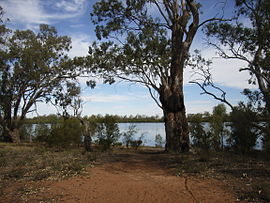Hattah-Kulkyne National Park
| Hattah-Kulkyne National Park Victoria | |
|---|---|
 Hattah Lake, within the national park. | |
 Hattah-Kulkyne National Park | |
| Nearest town or city | Mildura |
| Coordinates | 34°41′14″S 142°22′54″E / 34.68722°S 142.38167°ECoordinates: 34°41′14″S 142°22′54″E / 34.68722°S 142.38167°E |
| Established | 7 June 1960[1] |
| Area | 480 km2 (185.3 sq mi)[1] |
| Managing authorities | Parks Victoria |
| Website | Hattah-Kulkyne National Park |
| Footnotes | |
| Official name | Hattah-Kulkyne Lakes |
| Designated | 15 December 1982 |
| Reference no. | 264[2] |
| See also | Protected areas of Victoria |
The Hattah-Kulkyne National Park is a national park in the Mallee district of Victoria, Australia. The 48,000-hectare (120,000-acre) national park is situated adjacent to the Murray River, approximately 417 kilometres (259 mi) northwest of Melbourne with the nearest regional centre being Mildura. The national park was proclaimed on 7 June 1960 and is a popular destination for bushwalkers and school camping trips.[3]
History[]
In 1915, a sanctuary was formed to protect the beauty of the Hattah lakes. Ornithologist Les Chandler in 1949, with the late Reverend C. L. Lang, formed the Sunraysia Naturalists' Club (now the Sunraysia Naturalists' Research Trust) and was variously its president, vice-president, secretary, treasurer and editor. They agitated to have the Hattah-Kulkyne area declared a national park, which was achieved in 1960.[4][5][6][7][8]
Description[]
The park is in the Mallee district, famous for its red dirt and semi-arid shrub-like vegetation, mainly eucalypts. There are several lakes in the area, the largest of which is Lake Hattah. During the dry season most of the lakes and their streams dry out completely. Although there are limited road and tracks, there are several major high tension power and telegraph lines that run through or near the park, around which large areas are cleared. For management purposes, the Hattah-Kulkyne National Park is managed with the Murray-Sunset National Park, Wyperfeld National Park, and as part of the Victorian Mallee Parks.[1]
Important Bird Area[]
Over 200 bird species have been recorded in the park, which is overlapped by the Murray-Sunset, Hattah and Annuello Important Bird Area (IBA), so identified by BirdLife International because it contains mallee habitat supporting a suite of threatened mallee bird, including the malleefowl, black-eared miner and mallee emu-wren.[9]
See also[]
References[]
- ^ Jump up to: a b c Mallee Parks Management Plan (PDF). Parks Victoria (PDF). Government of Victoria. September 1996. pp. 1–3. ISBN 0-7306-6174-1. Retrieved 16 August 2014.
- ^ "Hattah-Kulkyne Lakes". Ramsar Sites Information Service. Retrieved 25 April 2018.
- ^ "Hattah-Kulkyne National Park and Murray-Kulkyne Park" (PDF). Parks Victoria (PDF). Government of Victoria. June 2014. Archived from the original (PDF) on 20 August 2014. Retrieved 16 August 2014.
- ^ Kloot T (1980) Obituary. Leslie Gordon Chandler. Emu 80, 241-242. https://doi.org/10.1071/MU9800241
- ^ L. C. Chandler (1934), "v. : ill., maps.; 34 cm.", Walkabout., Rex Nan Kivell Collection, Melbourne: Australian National Travel Association, ISSN 0043-0064, nla.obj-747971279 – via Trove
- ^ Hugh Wilson (1934), "v. : ill., maps.; 34 cm.", Walkabout., Rex Nan Kivell Collection, Melbourne: Australian National Travel Association, ISSN 0043-0064, nla.obj-749128577, retrieved 7 June 2021 – via Trove
- ^ Victorian National Parks Association, 1937, retrieved 7 June 2021
- ^ Australian Government; Department of Sustainability, Environment, Water, Population and Communities (June, 2011) Hattah-Kulkyne Lakes Ramsar Site Ecological Character Description
- ^ "IBA: Murray-Sunset, Hattah and Annuello". Birdata. Birds Australia. Retrieved 25 August 2011.
External links[]
| Wikimedia Commons has media related to Hattah-Kulkyne National Park. |
- "Hattah Lakes". Environmental sites in the Basin. Murray-Darling Basin Authority. Archived from the original on 19 August 2014.
- IUCN Category II
- National parks of Victoria (Australia)
- Mallee (Victoria)
- Protected areas established in 1960
- Ramsar sites in Australia
- 1960 establishments in Australia
- Mallee Woodlands and Shrublands
- Murray-Darling basin
